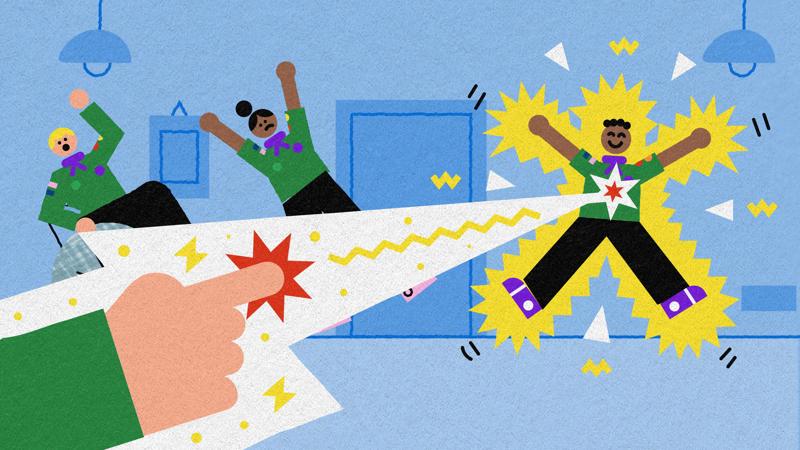
Play Zip, Zap, Boing!
You’ll need
- Pens or pencils
- Scrap paper
Before you begin
- Use the safety checklist to help you plan and risk assess your activity. There's also more guidance to help you carry out your risk assessment, including examples. Don’t forget to make sure all young people and adults involved in the activity know how to take part safely.
- Make sure you’ll have enough helpers for each team to have one. You may need some parents and carers to help if you’re short on helpers.
Setting up this game
- You could draw cue cards for the actions of zip, zap and boing. These could be used to prompt players while they’re learning the moves in this game.
To watch in full screen, double click the video
Playing the game
- Everyone should stand in a circle. Make sure everyone has enough room to do a star jump by asking everyone to make a star shape – their fingers shouldn’t touch the person next to them!
- For large groups, consider making two or three circles, each with eight to 12 players.
- Explain that in this game, play should be passed around or across the circle. There are three ways to pass play to the next person, which are Zip, Zap and Boing.
-
- Zip: One of these is ‘zip.’ ‘Zip’ only passes play along to the next person in the circle. You can ‘zip’ by clasping your hands together, with thumbs raised and index fingers pointing to the person in the circle next to you. You say 'Zip' as you do this. Have everyone practice by using ‘zip’ to pass play around the circle.nThe person who starts the ‘zips’ may pass ‘zip’ to their left or right. Henceforth, ‘zips’ move only in that direction. Each player should clearly say ‘zip’ and do the correct action, pointing to the next person.
- Zap: ‘Zap’ passes play to anyone in the circle. Demonstrate ‘zap’ by clasping the hands with thumbs raised and index fingers pointing, in the same way as ‘zip.’ You say ‘zap’ as you do this. The person who’s ‘zapped’ may pass play to their left or right with ‘zip,’ or indeed ‘zap’ someone else. Have everyone practice by using ‘zip’ and ‘zap’ to pass play around the circle. Each player should clearly say ‘zap’ and do the correct action, pointing to the person in the circle that they’re passing play onto.
- Boing: The final way to pass play along is ‘boing.’ Demonstrate ‘boing’ by doing a star-jump and saying ‘boing’ as you do it. Explain that ‘boing’ passes a ‘zip’ or a ‘zap’ back the way it’s just come. For example, if you wanted to reverse the way the ‘zip’ is travelling, you could ‘boing’. The person who’s ‘boinged’ can pass play to their left or right with ‘zip’, pass play to someone else with ‘zap’, or ‘boing’ back to the person who just ‘boinged’ them.
- Have a practice round with ‘zip,’ ‘zap’ and ‘boing’, so that everyone’s clear on the rules and knows what they're doing.
- Now, play the game.
- When someone makes a mistake, or hesitates for too long, they should sit down or step out of the circle.
- Everyone should watch and listen carefully as they try to catch other players out.
- Keep playing until there are just two people remaining. They're the joint winners!
Reflection
Getting to grips with the rules and actions of this game was probably challenging in such a short space of time. It helps to have a practice round where you can’t lose! Quickly learning and applying new skills is important for life, as we only get to do new things if we’re willing to try. When was the last time someone in the group had to do something for the first time (apart from this game)? Was it tough at first?
Safety
All activities must be safely managed. You must complete a thorough risk assessment and take appropriate steps to reduce risk. Use the safety checklist to help you plan and risk assess your activity. Always get approval for the activity, and have suitable supervision and an InTouch process.
- Active games
The game area should be free of hazards. Explain the rules of the game clearly and have a clear way to communicate that the game must stop when needed. Take a look at our guidance on running active games safely.
To make it harder, play the game so that ‘Zap’ passes play to anyone in the circle, except the two people either side of you.
Slow the game down to make it more accessible for everyone.
Remove the sound effects so that there are no loud noises.
If players are sitting, they could do ‘boing’ by simply throwing their arms in the air.
All Scout activities should be inclusive and accessible.
Once everyone knows the rules, allow Young Leaders and members of the group to run this game. If young people have ideas for new actions that could be added, try to practice and include these. You may need cue cards to help everyone if there’s more than three or four different ways of passing play.


